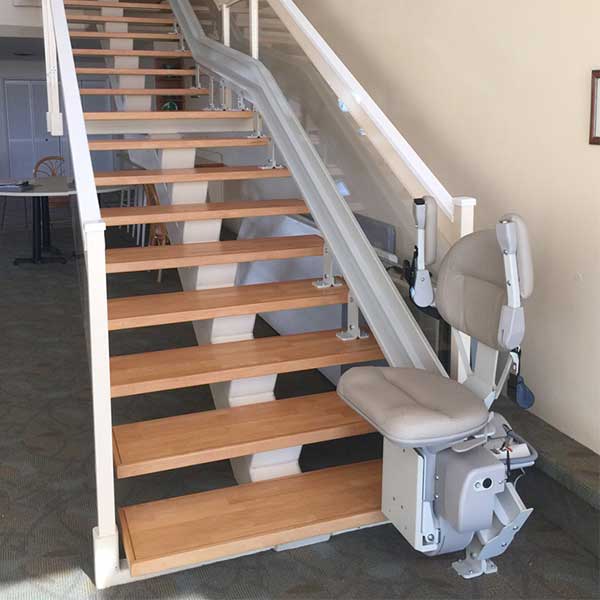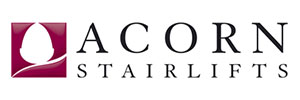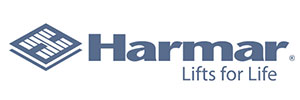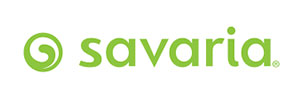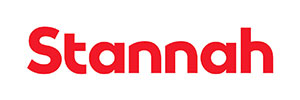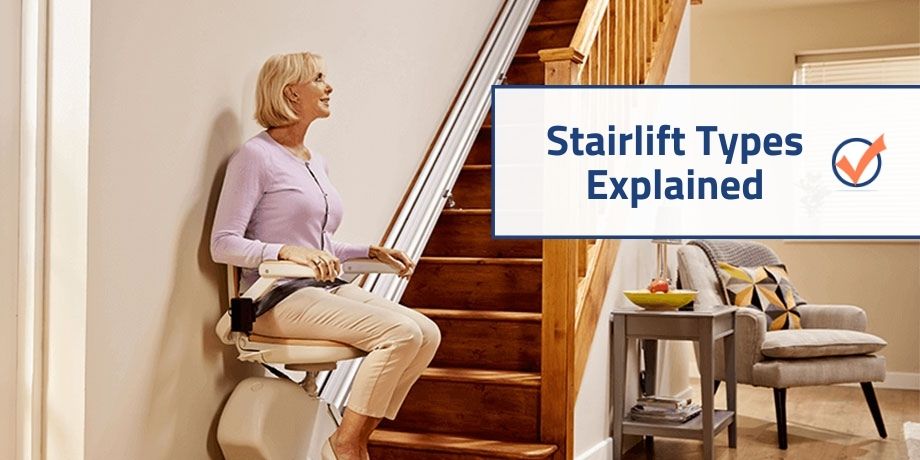
Stairlift Types
What are all the different types of stairlifts? Read about the five primary stairlift types, what options are available for each and what important details our experts believe all consumers should know.
Stairlift Types #1: Straight Indoor Stairlifts
Most residential staircases in North American feature 13-14 straight steps and typically go upstairs to second-story bedrooms, or downstairs to a basement living space or laundry area.
A maximum of 16 steps is allowable in a straight staircase before a landing is required. In general, stairways with landings call for curved stairlift systems – which are more complex and expensive than their straight stairlift counterparts. Given these points, it’s no surprise the majority of all stairlift installations are for straight indoor stairlifts.
Straight stairlifts seem simple in concept, but the rail designs, lifting capacities and comfort features vary greatly by manufacturer so it’s important to know what options are available.
Straight Stairlift Rail Design: Horizontal vs. Vertical
Straight indoor stairlift rails are usually made from aluminum and feature a horizontal or vertical structural design. A common means of driving the unit is the gear rack located on the rail. Most manufacturers, such as Harmar, Acorn, Stannah, Savaria and most Hanidcare models feature an exposed gear rack while Bruno uses a hidden, inverted gear rack.
“When a lightly greased gear rack is exposed, dirt and pet fur can end up working its way into the motor – even in the cleanest house,”
– Brian Matthews, President of Progressive Mobility in Pennsylvania.

In addition to concerns of dirt accumulation in exposed gear racks, horizontal rails also take up more space on the stairs, stairlift experts note. A vertical rail design installs closer to the wall, leaving maximum free space. For example, the Bruno “Elan” stair lift model installs 5 inches from the wall to the front of the rail. The equivalent measurement on an Acorn’s “Superglide” is 9-10 inches, Stannah’s “Scout” is nearly 6 inches and Savaria’s “SL-1000” is over 8 inches.
“Bruno’s rail design is very unique and the best design because it hides the gear rack. Almost all brands have the gear rack on top, and no one wants that — but they don’t realize it until the unit is actually installed.”
– Stacy Spiller, Partner at Transitions Lift & Elevator in Ohio and Kentucky
Another advantage of a vertical rail design is it extrudes less at the top of the staircase landing. Horizontal rails protrude further beyond the stairs, creating an unsightly appearance and potential trip hazard for family members.
Comfort Feature Considerations
While the “mechanics” of a stairlift are important to ensure a smooth, reliable ride, the overall comfort of the chairlift is also an important consideration. Here are a few factors that vary by stairlift brands and models but can greatly impact comfort:
- Padding on seat, back and arms
- Depth of seat
- Space between arms
- Adjustability between seat and footrest
- Sturdiness of seat
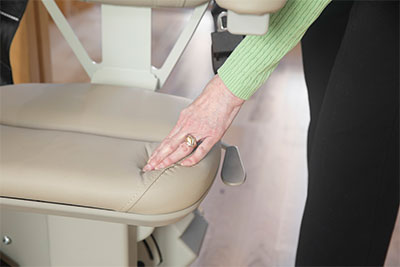
Homeowners often purchase stairlifts without sitting on various brands’ chairs to determine the differences in fit, comfort and sturdiness. For example, Acorn creates their stairlifts seats from molded plastic without padding; whereas, Stannah, Bruno and Handicare feature varying degrees of padding. Additionally, seat width and depth are also extremely important comfort factors and vary by stairlift manufacturer.
Ask your stairlift representative if they have a showroom where you can test different brands before buying. If your preference (or only option) is an in-home appointment, ask the stairlift rep if they have chair and rail samples they can bring along.
Straight Stairlift Options
Some manufacturers allow very little stairlift customization while other brands have multiple ways to personalize the lift to suit specific needs or wants.
Here are a few seat comfort considerations to remember to compare:
- Manual or power folding rail option
- Power swivel seat option
- Power folding footrest
- Colors
- Larger size seat or footrest
The most popular straight stairlift option is the folding rail. A folding rail allows the bottom portion of the stairlift rail to “fold” or “stack,” so the rail obstruction is removed. Folding rails are especially valuable when there is a doorway at the end of the steps, a narrow hallway, or an impediment to walking traffic.
Be aware that some manufacturers do not have a safety sensor in their power folding rails. A folding rail safety sensor will pull the rail back up if it encounters an object on its way down. This safety feature reduces the risk of a “crushing hazard” if an object is located beneath the folding rail.
Another popular option, especially for people with back problems, is a power-folding foot-rest. Instead of leaning over to fold the footrest manually, a power-fold option automatically lifts the stairlift’s footrest when the seat is placed in the stowed position.
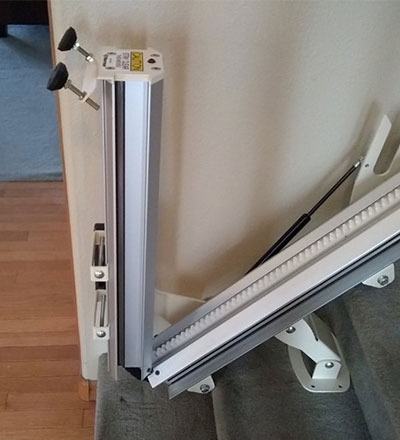
Stairlift Types #2: Curved Indoor Stairlifts
Stairlifts for curved staircases, spiral staircases and stairways with landings are more elaborate than straight stairlifts. Curved stairlifts vary rather widely by manufacturer, with significant differences existing between stairlift configuration, rail design, appearance, ride quality, weight capacity and more.
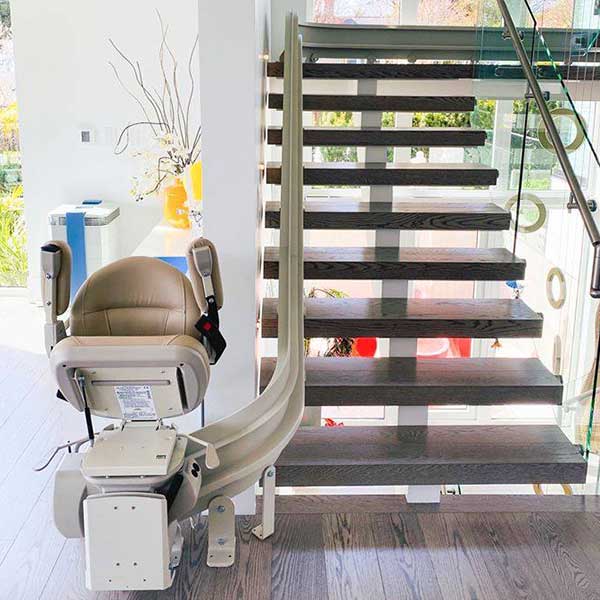
Types of Curved Stairlift Configurations
In addition to steps that curve or bend, stairways with landings are a common staircase configuration that require curved stairlifts. When a landing separates two flights of stairs, it is possible but not recommended to use two straight stairlifts. The safest stairlift option will always be one that takes rider from one floor to another with no transitions.
Some people purchase two straight stairlifts to save money since curved stairlifts are more expensive. However, service costs can be higher due to having two complete units. Two straight units in lieu of a curve can also create a safety issue since users must transfer from one stairlift to another. In addition to the safety concern, most homeowners find the appearance of two straight stairlifts obtrusive.
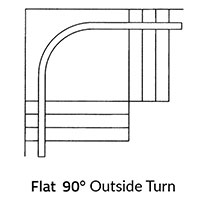
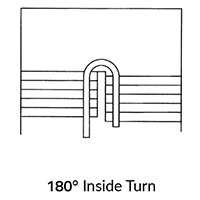
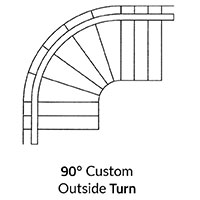
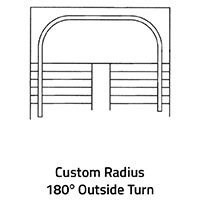
Differences in Curved Rail Designs
The best curved stairlift for your home equates to how closely it fits your staircase, how smoothly it rides and how well it blends in with your home. The factor that most influences those considerations is rail design.
The four main types of curved stairlift rails on the market are:
- Modular
- Hand-Crafted
- Double-Tube
- Single-Tube
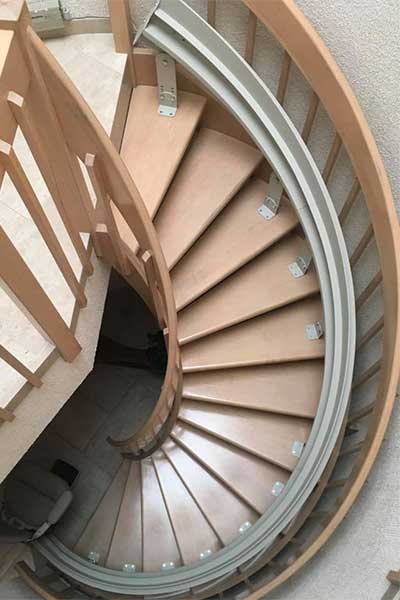
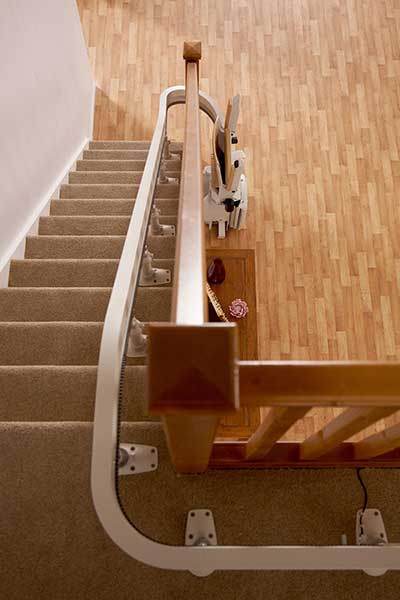
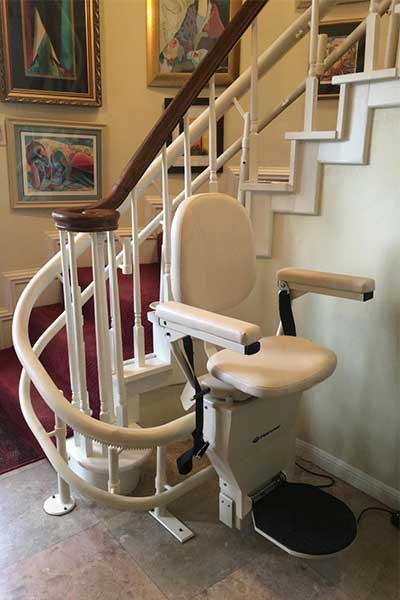
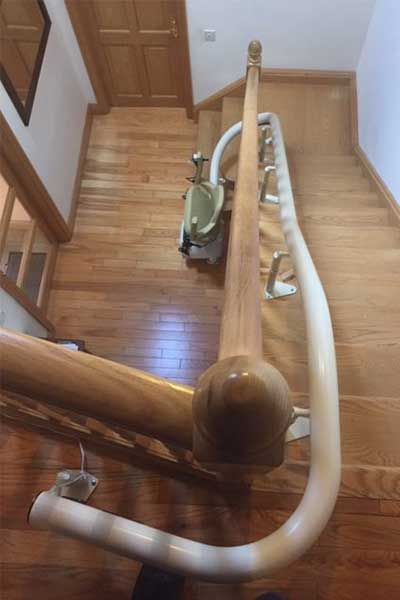
Modular Curved Stairlifts
Acorn stairlifts use a modular rail design for their curved units. The advantage of a modular unit is quick installation. If you need a curved stairlift immediately, a modular unit is usually the fastest choice. A strong disadvantage, often cited, is the rail fit does not follow the curve of the stairs very closely since it is “out of the box.”
Because of the modular nature of Acorn curved stairlifts, you receive the closest fit “ready made” rail they have on their truck. The fit is often far from ideal, causing the rail to be installed well into the stairs. That translates to less open space on the steps.
Hand-Crafted Curved Stairlifts
A custom curved stairlift, such as a Bruno curved rail, is hand-crafted to the exact measurements of your stairs. The result is a rail that follows the precise lines of your stairs, maximizing space on the steps. The potential disadvantage is the lead time for welders and fabricators to craft the product.
Double-Tube Curved Stairlifts
Savaria, Stannah and Harmar and a Handicare model use a “two-tube” rail system. A two-tube rail can appear obtrusive since the top tube can end up nearly as high as a handrail and the lower rail includes an unsightly fully-exposed gear rack.
Ride quality on tube and modular systems is often cited as “uneven” due to the many splices in the rail.
“These kinds of rails consist of many pieces, about 2 feet long, so the stairlift bumps on every splice. We like Bruno custom rails because they are handcrafted so there are often only three pieces to a curve and the splices are perfect. It’s a heavy-duty, sturdy rail. There’s really no comparison,” noted Spiller.
Single-Tube Curved Stairlifts
Handicare also features a single tube curved system. Uneven ride quality can also be a downfall of a single-tube stairlift system. One stairlift professional explained that single-tube stairlift systems use a complicated leveling system compared to other stairlifts. This can result in small shifting movements when riding the lift.
Single or double-tube system rails also ride more slowly. The hand-crafted curved rail system offered by Bruno features an extraordinarily-smooth ride, which is credited to their custom fabrication process.
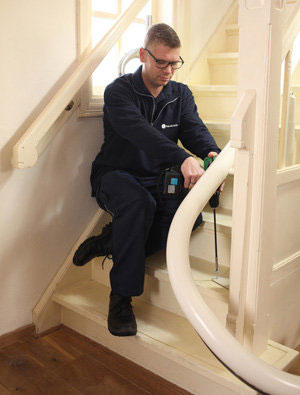
“Many curved stairlifts can have rough ride because of the seams. People sometimes refer to it as feeling like they can fall out of the chair when it has a minor jerk. I’ve installed Acorn, Harmar and Bruno, but I always say I prefer the quality of Bruno because it is sturdy overall and has a smooth ride.”
– Robert Bevins, Home Safety Specialist for Kohll’s Pharmacy in Omaha, Nebraska.
Curved Stairlift Options
Park Position Option: Most manufacturers have similar options for curved stairlifts. One popular option is a top or bottom “park position” that extends the rail beyond the stairs. This allows users to get on/off the chair away from the steps and park the stairlift away from the staircase.
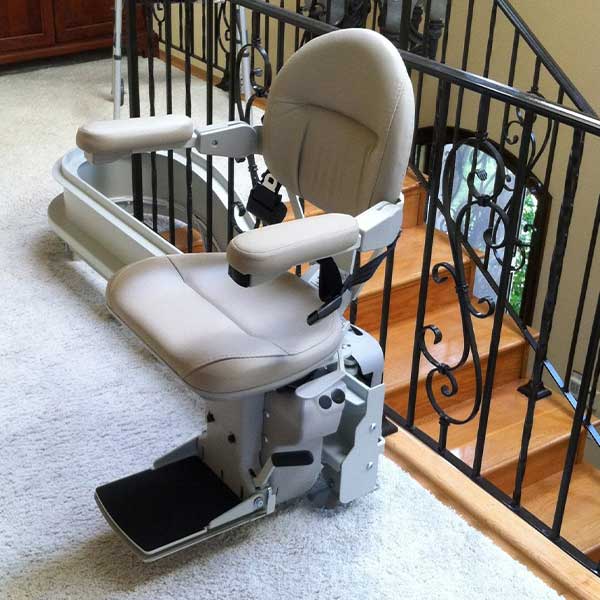
Power Options: When a stairlift is not in use, people often choose to fold the arms, seat and footrest in an upright position to create maximum open space on the steps. If you have back problems, an optional power folding footrest may be convenient since the footrest will auto fold when you flip up the stairlift seat. Likewise, a power swivel seat is a great option for riders who may struggle pulling the swivel lever to exit the chair.
Extra-Large Options: If taking advantage of the Bruno Elite Curve’s 400 lb lift capacity is a necessity, options for an extra wide seat and/or larger footrest can help increase your comfort.
Mid-Rail Park/Charge: Sometimes used in split-level homes, a mid-rail park/charging station allows you to exit the chair at a landing in the middle of the staircase and the stairlift will continue to “charge.” Otherwise, curved stairlifts only charge when parked at the top or bottom of the rail.
Colors and Fabric Options: Several manufacturers allow stairlift customization using different colors, fabrics and different colors of rails. Ask your stairlift representative about options to match your individual style, furniture, wall coverings or decor.
Stairlift Types #3: Straight Outdoor Stairlifts
Outdoor stairlift are often used on porches, decks or stairways traveling down to water access. While outdoor stairlifts are not as popular as their indoor counterparts, they significantly help people with mobility challenges access the outside of their home and property.
Even though most stairlift manufacturers offer outdoor straight chairlifts, significant differences exist between the models. Bruno’s outdoor straight stairlift installs 5 inches from the wall, in contrast to Stannah’s model that installs within 8 inches. Another point of differentiation is the lift capacity of available outdoor straight chairlifts. Harmar, Acorn, Stannah and Handicare’s models range from 280 lb 350 lb lift capacity, whereas Bruno’s offering accommodates up to 400 lbs.
All outdoor straight stairlift manufacturers use aluminum rails. Most brands also feature weather-protected components and a cover included with the chairlift. Harmar and Bruno are both performance-tested from 0° F – 125°F. Bruno’s outdoor straight stairlift comes with a 5-year Limited Warranty, while Harmar offers a 3-year warranty and Handicare a 2-year warranty.
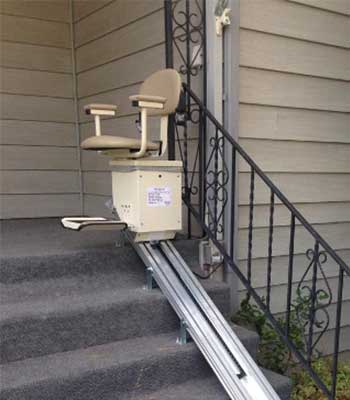
Stairlift Types #4: Curved Outdoor Stairlifts
If your outdoor staircase has angles or an uneven drop in grade, a curved stairlift is required. While there are multiple choices for outdoor straight stairlift brands, your options are more limited if you need an outdoor curved stairlift.
Bruno and Handicare offer curved outdoor stairlift solutions. Much like their indoor stairlifts, the rail design dramatically differs between the two brands. Handicare uses a two-rail tube construction whereas Bruno handcrafts their vertical rail. Another key point to remember is that outdoor curved stairlifts are only available up to 60 feet in length. Accommodations for longer staircases would include the installation of two separate stairlifts.
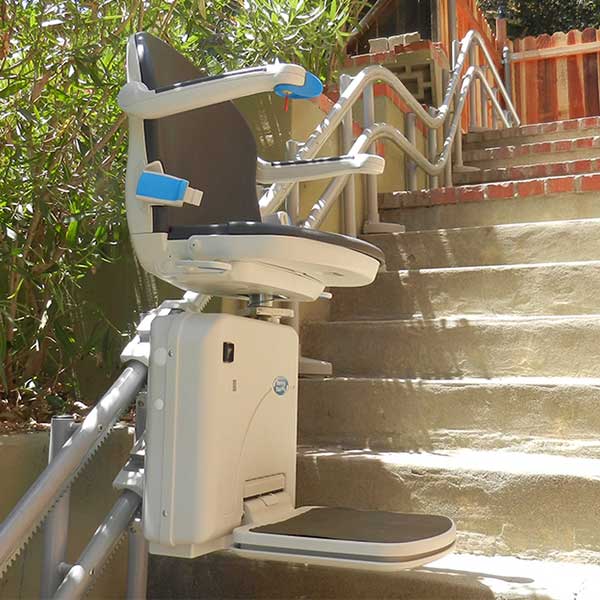
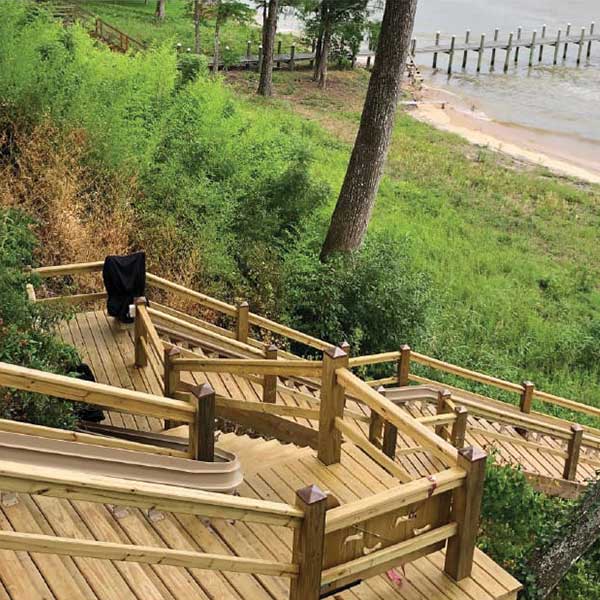
Stairlift Types #5 | Commercial Stairlifts
Whether or not a stairlift is considered a commercial application is determined by local building codes. In general, if you have a residential dwelling with two-or-more family units sharing a common staircase, it is considered a commercial stairlift installation due to fire egress requirements. Churches, businesses, schools and basically any other public facility are common commercial stairlift applications.
